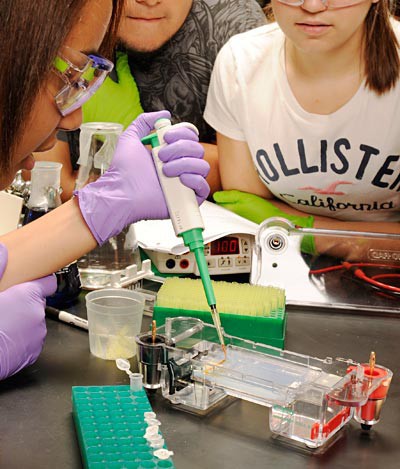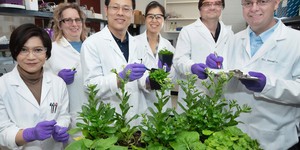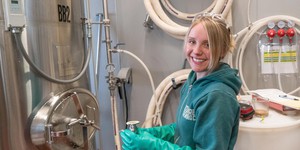Log In
Summary
Areas of Science
Difficulty
Time Required
Long (2-4 weeks)
Prerequisites
A basic understanding of molecular biology and access to a research laboratory with PCR and gel electrophoresis equipment are required for this project.
Material Availability
The kit required for this project can only be purchased through a school or educational business.
Cost
Very High (over $150)
Safety
Adult supervision is required in the laboratory facility.
Credits
Sandra Slutz, PhD, Science Buddies

*Note:
For this science project you will need to develop your own experimental procedure. Use the information in the summary tab as a starting place. If you would like to discuss your ideas or need help troubleshooting, use the Ask An Expert forum. Our Experts won't do the work for you, but they will make suggestions and offer guidance if you come to them with specific questions.
If you want a Project Idea with full instructions, please pick one without an asterisk (*) at the end of the title.
If you want a Project Idea with full instructions, please pick one without an asterisk (*) at the end of the title.
Abstract
Genetically modified organisms (GMOs) are organisms whose DNA have been manipulated to give them new traits. In genetically modified (GM) food crops traits like resistance to drought or pesticide might be added, or the crop may have been made more nutritious, or the taste may be altered to give you something like the impossible burger. Are there GMOs in your favorite foods? Many countries have implemented or are in the process of implementing GMO labeling on foods, but with a little bit of molecular biology know-how you can test your favorite foods yourself! Start out by researching how and why GMOs are made as well as their safety record. Then pick a few foods to test and use the GM Food and Amplification Kit from our partners at Carolina Biological to do your own testing. You will need access to a laboratory with equipment to carry out PCR (polymerase chain reactions) and gel electrophoresis. Which foods do you think use GMOs and why do they do it?
Figure 1. You can perform PCR and DNA electrophoresis, which is shown here (a gel is being loaded with DNA), to test for GMO-products. (Photo courtesy of Bio-Rad Laboratories, Inc.)
Ask an Expert
Do you have specific questions about your science project? Our team of volunteer scientists can help. Our Experts won't do the work for you, but they will make suggestions, offer guidance, and help you troubleshoot.
Global Connections
The United Nations Sustainable Development Goals (UNSDGs) are a blueprint to achieve a better and more sustainable future for all.
This project explores topics key to Zero Hunger: End hunger, achieve food security and improved nutrition and promote sustainable agriculture.
Careers
If you like this project, you might enjoy exploring these related careers:
Career Profile
As the world's population grows larger, it is important to improve the quality and yield of food crops and animal food sources. Agricultural technicians work in the forefront of this very important research area by helping scientists conduct novel experiments. If you would like to combine technology with the desire to see things grow, then read further to learn more about this exciting career.
Read more
Career Profile
With a growing world population, making sure that there is enough food for everyone is critical. Plant scientists work to ensure that agricultural practices result in an abundance of nutritious food in a sustainable and environmentally friendly manner.
Read more
Career Profile
A nice cool yogurt is the perfect snack. It comes in a variety of delicious flavors like peach, chocolate, and cherry and contains calcium, vitamins, and minerals that are good for you. Yogurt also contains live cultures that your body needs to maintain good health. How did all of those good things get into your yogurt? The answer is that a biochemical engineer helped to develop a recipe to make that yogurt a perfect snack for you. So many of the products that we use every day, from medicine…
Read more
Related Links
- Science Fair Project Guide
- Other Ideas Like This
- Biotechnology Project Ideas
- Genetic Engineering Project Ideas
- My Favorites
Cite This Page
General citation information is provided here. Be sure to check the formatting, including capitalization, for the method you are using and update your citation, as needed.MLA Style
Slutz, Sandra.
"Genetically Modified Foods." Science Buddies,
20 Nov. 2020,
https://www.sciencebuddies.org/science-fair-projects/project-ideas/BioChem_p025/biotechnology-techniques/genetically-modified-foods?class=AQUWmtU6n4iddmzbc9k3Gt0B0mQ08oqojRfM7MA__cby5nTGjQf3MWaZiT4rtclMAIYZlG_vWa9uf37YdSnRSf6-.
Accessed 26 Apr. 2024.
APA Style
Slutz, S.
(2020, November 20).
Genetically Modified Foods.
Retrieved from
https://www.sciencebuddies.org/science-fair-projects/project-ideas/BioChem_p025/biotechnology-techniques/genetically-modified-foods?class=AQUWmtU6n4iddmzbc9k3Gt0B0mQ08oqojRfM7MA__cby5nTGjQf3MWaZiT4rtclMAIYZlG_vWa9uf37YdSnRSf6-
Last edit date: 2020-11-20
Explore Our Science Videos
Build a Mini Rain Garden
Volleyball Machine: 2019 Engineering Challenge
Can you solve this air pressure puzzle?










